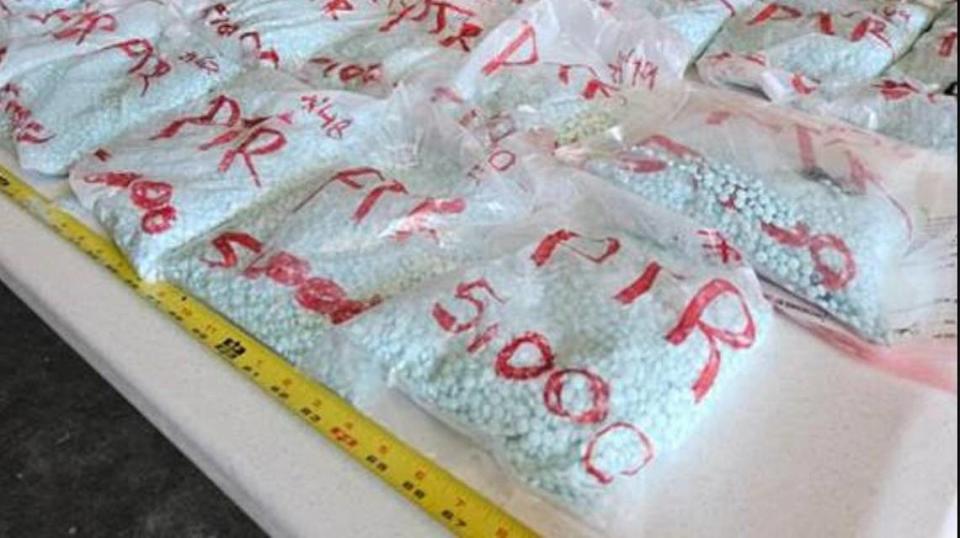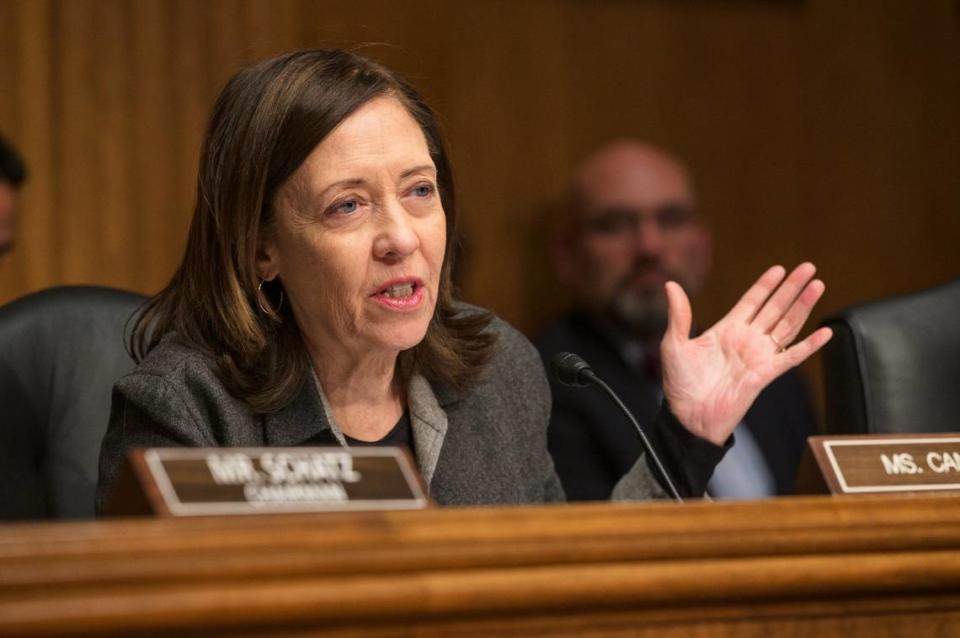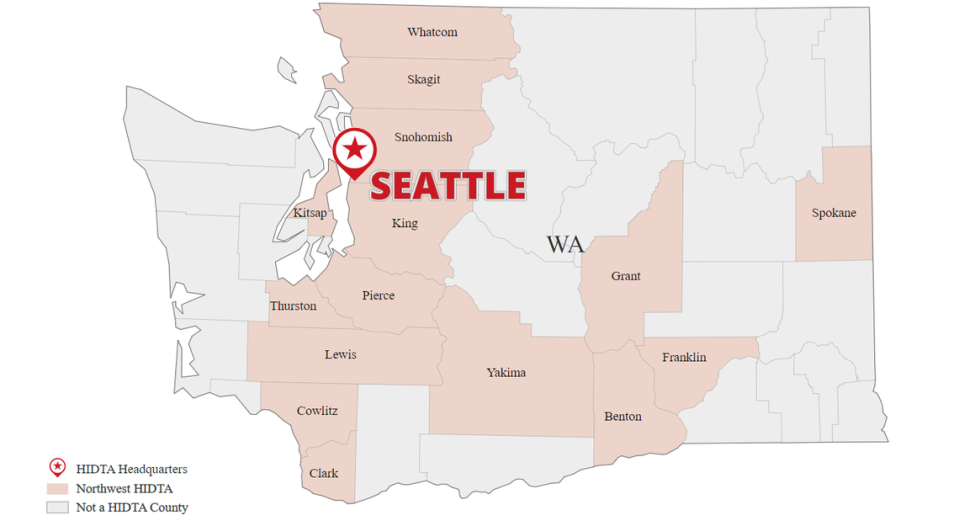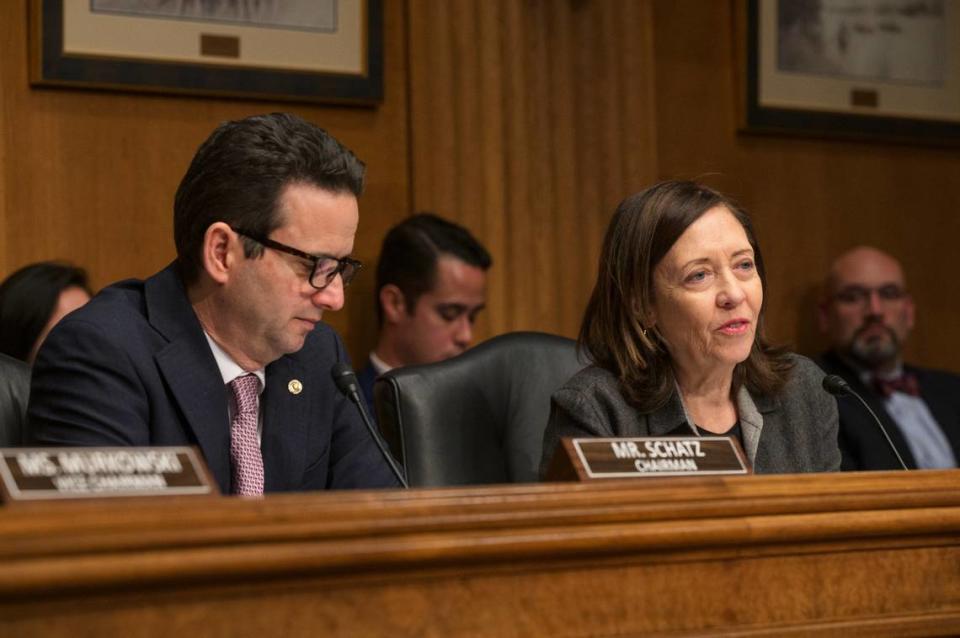‘A train wreck for a long time.’ Senate committee talks fentanyl problem in Indian Country
- Oops!Something went wrong.Please try again later.
Tensions rose on Wednesday in Washington, D.C. at a Senate Committee on Indian Affairs oversight hearing on the ongoing crisis of fentanyl — a deadly synthetic opioid 100 times stronger than morphine — in Indian Country.
The Dec. 6 hearing was a follow-up to last month’s oversight hearing that brought forth a Native perspective on addressing the ongoing crisis, including testimony from Tribal leaders across the country.
In 2021, American Indians and Alaska Natives experienced the highest rate of opioid overdose deaths among any racial or ethnic population, according to the Centers for Disease Control and Prevention. More than 1,300 Native lives were lost due to overdose that year.
This most recent hearing brought federal voices to the table, with a panel composed of Deputy Director of the White House Office of National Drug Policy Adam W. Cohen; Indian Health Service Director Rosalyn Tso (Diné); U.S. Attorney, Eastern District of Washington Vanessa Waldref; and Bureau Deputy Director, Bureau of Indian Affairs (BIA) Glen Melville (Makah Tribe).
Opioids in Indian Country
Much of the discussion centered around the gaping disparities in Tribal law enforcement resources and checkerboard jurisdictions that make Indian reservations ideal operating centers for drug traffickers. Lawmakers, who are responsible for funding the agencies that deliver resources to Indian Country, grilled the panelists on how effective their programs are in mitigating the fallout from the fentanyl crisis in Native communities.

Before the hearing began, Committee Chairman Brian Schatz (D-HI) gave brief remarks, referring to the breadth of issues that leave Indian Country vulnerable to drug trafficking and opioid addiction: checkered jurisdiction, minimal data, barriers to healthcare resources, housing insecurity, and staffing.
“The United States must live up to its trust and treaty responsibilities to promote the health and well-being of American Indians, Alaska Natives, and Native Hawaiians,” Schatz said. “That responsibility includes responding to modern threats, including fentanyl.”
During the hearing, Sen. Maria Cantwell (D-WA) brought attention to the crisis in eastern Washington, where tribes contend with heavy drug trafficking and high overdose rates.
According to the Washington State Department of Health, opioid overdose deaths among American Indians and Alaska Natives has been climbing steadily in the state over recent years. There were 24 recorded deaths of this kind in 2020, 67 in 2021 and 92 in 2022.
The prevalence of drug trafficking and overdoses in eastern Washington led to a specialized task force across several agencies, the Southeast Washington Safe Streets Task Force. Between heightened efforts from the U.S. Attorney’s Office and multi-agency responses, 2023 has had many reports of success in catching and prosecuting high-level distributors.
“There are challenges in rural communities,” said U.S. Attorney Waldref. “And we have that throughout the Eastern District. There are rural communities that can be areas to hide those drugs. What we do to try and address that, and to effectively prosecute these cases, is having the most effective information sharing that we possibly can.”
Drug prevalence in WA tribes
In September, The Lummi Nation, located in the Puget Sound region, saw four deadly overdoses in as many days, prompting the Tribe to take emergency measures such as enacting random traffic stops and condemning several properties known for drug activity.
Cantwell spoke of understaffed and underresourced tribal law enforcement. Earlier in the year, she said, federal, state, local, and tribal law enforcement seized more than 100 pounds of fentanyl before it reached the Colville and Yakama Tribal communities, and just last week, officers seized 18,000 fentanyl pills outside of Spokane.

“So, make no mistake about it — the fentanyl crisis is a flood of poison entering Indian Country and communities, and it is not a crisis that our Tribes can face alone,” Cantwell said. “We’ve heard [from] tribal leaders and their law enforcement agencies [about] how they’re chronically understaffed and underresourced. And in eastern Washington, just a handful of officers are responsible for patrolling thousands of square miles of tribal land, and they can’t shoulder that burden alone.”
For example, Yakama Nation Tribal Police is a small organization that often works with the Yakima Police Department and Yakima County Sheriff’s Office on intense cases. Yet, the Yakama Nation Reservation is the largest Indian reservation in the state, stretching over 1.1 million acres.
Cantwell then posed a question to BIA’s Melville, asking if the remote nature of Tribal nations, paired with the lack of law enforcement, make reservations ideal for drug traffickers to operate.
“There is a well-known fact, in the Mexican cartels, that if you can go on to an Indian reservation and work your way into an Indian reservation … that’s an area that they know that they can try to utilize and manipulate,” Melville responded.
Trafficking, police presence in Indian Country
Federal funding for law enforcement in Tribal communities has long been inadequate, with many Tribal agencies being forced to make due with limited staff covering large rural areas, experts say. According to the most recent data, there were 3,834 full-time sworn officers in 234 tribal-operated law enforcement agencies across the United States.
That’s an average of about 16 officers per agency.
Generally, reservations include many rural areas. Across the country, there is an estimated 56.2 million acres of land on reservations — yet only 234 law enforcement agencies, most of them too small for their operating area.
Some Tribal Nations don’t have their own law enforcement agencies and instead rely on agents from their regional BIA office, Sen. Catherine Cortez Masto (D-NV) said. For the tribes without their own enforcement in border states such as Nevada, where the regional BIA office also covers Colorado and Arizona, that isn’t enough, Masto told the committee.
Sen. Cantwell introduced legislation earlier this year, hoping to increase those numbers. By labeling tribal enforcement officers as federal law enforcement officers in certain aspects, the legislation would raise the retirement, pension, injury and death benefits to match federal officers’.
Lawmakers at the hearing focused on the High-Intensity Drug Trafficking Areas (HIDTA) program, which provides special assistance to federal, state, local, and tribal law enforcement agencies operating in areas determined to be critical drug trafficking regions.
There are 33 HIDTA regions across the U.S., including 14 that work directly with Tribal Nations. Within those 14 regions, the White House’s Cohen said, authorities have seized more than $414 million in assets over the past year. The HIDTA program has an annual budget of $290 million, with no dedicated budget set aside for Tribal Nations.
One of these regions is the Northwest HIDTA, headquartered in Seattle. It includes many counties in Washington state, from Whatcom County down to Clark County, and over through Yakima, Benton and Franklin counties.

Sen. Lisa Murkowski (R-AK), vice chair of the committee, asked Cohen if there should be a set-aside: “Should there be, given the statistics, given what we know, given the impact on Indian Country, on Alaskan Natives, Native Hawaiians?”
“I think that’s something worth considering,” Cohen replied.
Opioid Reduction Task Force
Sen. Markwayne Mullin (R-OK), an enrolled member of the Cherokee Nation, spoke of the U.S. Department of the Interior’s Opioid Reduction Task Force, launched in 2018 to crack down on drug trafficking in Indian Country. During the hearing, Mullin submitted to the record a 30-page report addressed by the task force to Congress, alleging that he hasn’t heard anything from the current administration on the task force’s findings.
“I haven’t heard anything, not a word,” Mullin said. “I helped with this task force, I brought some reality to it ... I am at a loss.”
BIA’s Melville confirmed that the task force still needs to be followed up on.
“That’s a problem,” Mullin replied.

‘This is our fault’
With 20 minutes left in the hearing, Sen. Jon Tester (D-MT) posed a question that is emblematic of the federal government’s failure to meet the stated needs of Indian Country in prosecuting drug offenders.
“This has been a train wreck for a long time, through multiple administrations, regardless of which party has been in the White House,” Tester said. “A lot of this falls on us, making sure that the BIA has enough resources to be competitive.
“This is not your fault. This is our fault, the folks on this side of the rostrum. It’s not these folks that are the problem, every one of us here understands that we have got to have money in the budget to hire BIA officers, and if they don’t have the budget ... it’s on us ... we have a lot of work to do.”
This article was produced by Native News Online and republished in collaboration with McClatchy News.

